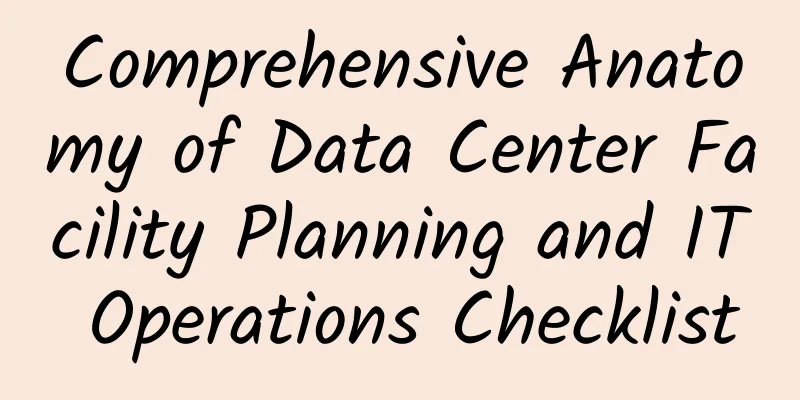Comprehensive Anatomy of Data Center Facility Planning and IT Operations Checklist

|
Making the right choices in terms of data center vendor and facility type will prevent you from paying a high price later due to inadequate service capabilities and various mistakes. Whether you are looking to outsource your data center, move to a new facility, or plan an upgrade, you should carefully review your plans before putting them into action.
Here is a vendor-independent data center review checklist that allows you to conduct a fair assessment of candidate hosting or colocation providers before signing a contract - if your business relies on these providers' servers, storage, network and other facilities, you should look at this checklist. This checklist can also be used as a standard template to evaluate your current operations and as a reference for new designs of internal data centers. As you compare facility capabilities, remember that you are evaluating only history at a point in time. As needs and business directions change, you must periodically reevaluate these facilities to find the right facility solution that keeps pace with your business. You can use this data center review checklist as a foundation and then add items that fit your own industry or business needs. Review of computing facilities Many organizations complete these reviews with the data center vendor that provides the computing facilities. Others who should be involved in the review include those responsible for selecting, installing, and maintaining the facilities in their own or leased data center. o Review computing facilities for compatibility with existing applications Survey your current full range of servers, storage arrays, network switches, and other IT equipment. Summarize available computing resources and verify that they are compatible with each other and have sufficient capacity to support your existing applications. Legacy or custom applications with specialized hardware requirements may have issues on hosted servers. Each operating system and hypervisor may present compatibility issues. Check to see if the outsourcing provider will offer replacement equipment or support for equipment your IT organization already owns. o Review the rapid equipment replacement plan and detailed process How old is the current data center computing infrastructure? When was the last equipment replacement? When is it due for replacement? What new equipment is planned to be introduced? These insights will guide the development of server consolidation and workload balancing plans. Since your business system runs on the data center service provider's equipment, the service provider should transparently disclose its technology refresh plan to you. oOptimize the equipment replacement process The equipment replacement process is disruptive, so suppliers must communicate with users about update and upgrade plans and work with users to mitigate the impact on work caused by equipment changes. Will workloads remain operational during the equipment upgrade? Is there adequate communication about the inevitable disruptions that occur during the upgrade? Do you have a plan for such disruptions, such as backing up or temporarily migrating workloads in advance? oExperienced local staff and expert support How many IT professionals can be on call 24/7 (even the most ordinary workers can complete the operation as long as they can follow the guidance of the remote expert team)? If the data center is understaffed or the technicians are not on site and have to be dispatched temporarily, outages will harm critical applications. Are service response times planned? Are escalation routes clearly agreed upon in the service level agreement (SLA)? Use regular phone calls to verify the support team's response time and service quality. oManagement and performance tools How do you measure and monitor the performance of your systems? If you are dealing with an outsourced vendor, do you have access to all or some of this information? Hosting companies don't usually reveal overall environment data, but if you rent their equipment, consider getting this information through a web portal or application performance monitoring (APM) tool. You may need to set up your own APM system to ensure SLA compliance. oHigh network bandwidth Network bandwidth information should be verified and announced in the SLA. 10Gbps network bandwidth is common for data center service providers. Include network bandwidth indicators in the real-time performance monitoring of the system. Can you use more burst bandwidth, and what will the corresponding cost be? On the other hand, can you control costs by limiting bandwidth, or implement load balancing among multiple sites to avoid overloading a single site? Security and access control Physical tampering and theft can lead to data loss and expose company secrets. The cause of security compromise may be the data center operator, the IT department, or both. oPhysical security Are computing facilities securely located in the data center? Optional measures include one-way entrances to the data center, locked cabinets in private equipment areas - each cabinet uses an individual physical or electronic key, and locks on areas that can access private data, such as cable channels and patch panel areas. oAccess Documentation Can you track the activities of employees, contractors, vendors and visitors? Keep an eye out for these methods: sign-in sheets, comprehensive camera logs, electronic badges or biometric measures. Is there a permanent log of anyone who has access to your equipment, cable pathways, patch panels, or any other area associated with your workloads and data? This is especially important in multi-tenant facilities, where a technician's actions on one server could affect multiple clients. oInternal security personnel Some data center providers go beyond video surveillance to include full-time security staff—even hiring armed guards—to perform visitor and vendor tracking, provide 24/7 access to the data center, and interface security information with law enforcement or other security lines. oProtect your devices and data Storage components going offline or changing their purpose can easily lead to data leakage. Are there proper storage or destruction measures for old, obsolete or broken disks? When disks are removed from local servers or storage arrays, are they tracked and safely stored? Who is responsible for destroying the disks, and if an outsourced partner is responsible for handling them, can they provide written documentation? Facility Planning Data centers provide long-term and reliable services, and qualified building facilities can even allow you to not worry about facility management in the future. oSafe location The process of selecting a data center is to select a location. The building should be away from common environmental hazards, such as flood plains and earthquake zones. It should also avoid being near man-made danger areas, such as industrial centers - refineries or chemical plants, airports on major flight paths, major highway interchanges or railways. oConvenient transportation and installation Evaluate any measures that can speed up the deployment and replacement of equipment. For example, indoor shipping/receiving docks can allow workers to move and unload IT equipment without exposing it to rain or snow. If the data center is a multi-story building, the elevator should be close to the unloading point. The data center's cargo escape should be wide enough to accommodate oversized equipment, such as full-height cabinets that include rack cooling units. It is also very useful to set up access transfer points or burn-in test areas, where equipment can be pre-installed and tested before being transferred to the production environment. oOffice facilities If you support staff working on-site, make sure the facility has some dedicated offices, cafeterias, or other humane spaces away from the heat and fan noise of server equipment to work in. Bathrooms or nearby hotels can help employees feel comfortable working overtime at remote data center facilities. oEnvironmental control and safety features Investigate whether the building has advanced smoke detection measures and fire suppression measures based on dry powder fire extinguishers. The facility should use modern electrical grounding standards, such as polyaniline grounding, to ensure safety. Because many facilities use water as a cooling medium (e.g., in chillers or heat exchangers), comprehensive leak detection is critical. oSufficient power and recoverability As energy becomes increasingly expensive and scarce, not every region will have sufficient electricity supply. Choose a data center location where energy is relatively cheap and abundant, because areas with energy shortages will also have higher electricity costs. Find a second grid provider to power the facility through a separate substation, use generators for backup power capabilities, or place the data center near an alternative power center such as a wind farm. If using an industrial-scale, uninterruptible fuel cell generator, such as a Bloom Energy battery array, the data center will need to be close to a natural gas or other biogas source. oReliable cooling Data centers are typically cooled using a combination of conventional mechanical air conditioners and chilled water heat exchangers, but even a brief outage in the cooling system can cause significant operational losses. Verify that the cooling units have redundant backup units and that the backup units are using redundant power supplies. The cooling capacity should also be able to accommodate future growth. The humidity control system must maintain the correct humidity level for both the comfort of personnel and the safety of electronic equipment. oStandards and regulatory compliance Verify that you comply with data center mandatory standards for your industry and have relevant documentation and certifications. Standards related to data centers include SAS 70 II and PCI DSS. oNetwork connectivity and operators Find out which carriers are connected to the data center, such as Cox, AT&T, Verizon and other regional companies. A neutral hosting or colocation provider should support multiple regional carriers and lines for redundancy, with each line using an independent connection and access to the data center room via different fiber optic cables. |
<<: Facebook: An innovative data center network topology
>>: Log Analysis for Software Defined Data Center (SDDC)
Recommend
Is Graph Data Science the Secret to Accelerating Machine Learning?
In the past decade, the field of machine learning...
LOCVPS recharge 300 yuan in June and get 30 yuan, 20% off Hong Kong/Korea/US/Australia VPS monthly payment starts from 29 yuan
LOCVPS has launched this year's 618 promotion...
Talk about how 5G and AI work together from the perspective of 5 major industry applications
As new technologies continue to emerge, more and ...
Will 5G applications enable hardware storage updates or the expansion of cloud services?
As functional evolution and experience improvemen...
The Trump administration changes its policies overnight: the study visa rules are changed back to the old ones, and the new policy was aborted in less than a week
This article is reprinted with permission from AI...
IPv6 series - 10 common problems for beginners
Based on the problems encountered by myself and m...
5G is here, and so is mainstream adoption for industrial IoT startups
Making machines communicate with humans is the be...
LOCVPS 10th Anniversary: Top up 1,000 yuan and get 100 yuan, 20% off for all items, Hong Kong VPS annual payment starts from 300 yuan
The established domestic merchant LOCVPS (Global ...
Nearly 150 universities have adopted the simplified Ethernet all-optical network: it is not only as simple as 10G access to the room and simplified operation and maintenance!
[[416673]] In the first year of the 14th Five-Yea...
A complete history of web crawlers
[[415987]] The well-known research organization A...
2G quietly withdraws from the network, 4G grows steadily, and it is still a bit far to talk about 5G now
The withdrawal of 2G/3G networks is not a new top...
The number of 5G mobile phones will reach 250 million. Is this good news?
According to a new research report released by St...
Four questions and answers to help you understand the principles and applications of blockchain in seconds
Starting with Bitcoin, the decentralized and data...
PacificRack VPS is 50% off for a limited time, 8 cores, 16G memory, 61 IPs for only $50
PacificRack is now offering a promotion for Multi...
Three approaches to Bluetooth low energy development
Ask any IoT vendor what makes their product excit...









